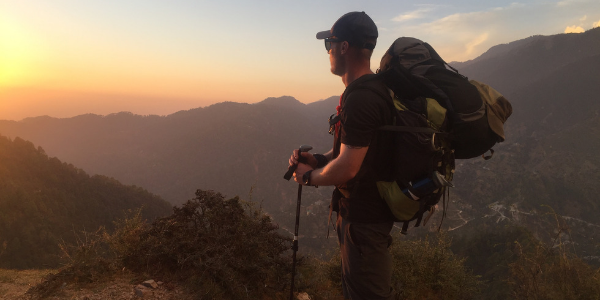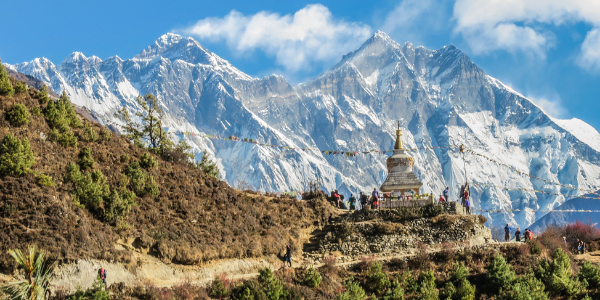How to Climb the Himalayas
You have more than likely heard of the Himalayas; the tallest mountain range in the world and home to Mount Everest, but would you know how best to explore this fascinating area? Since the first successful summit of Mount Everest on 29th May 1953, the Himalayas have become far more accessible to walkers. With new roads and airports, luxury lodges and an array of different trekking routes available, more and more people journey to the Himalayas every year.
The Himalayas
The Himalayas are home to the world’s largest mountains, including the highest peak – Mount Everest, standing at an incredible 8,848m tall. This incredible mountain range is a result of tectonic plate movement that collided India into Tibet and stretches for 2,400km.
The Himalayas, passing through India, Pakistan, Tibet, Bhutan and Nepal, are home to the highest mountains, deepest gorges and the greatest biodiversity on the planet including the majestic snow leopard! The name ‘Himalaya’ means ‘Abode of Snow’ and has developed into the plural Himalayas, due to the number of different mountain ranges in the area. There are the Outer Himalayas, the Lower Himalayas, the Tibetan Himalayas, the Trans-Himalayas and the Great Himalayas, home to Mount Everest.

Trekking in the Himalayas
Where?
The Nepalese Himalayas are home to the world’s giants including Everest (8,848m), Kanchenjunga (8,586m) and Makalu (8,463m). The two most popular trekking destinations in Nepal are the Khumbu region; located below Mount Everest, and the Annapurna region; full of magnificent scenery and picturesque mountain villages.
The Indian Himalaya region is filled with stunning mountains, beautiful scenery and an array of diverse wildlife. The Indian Himalayas are one of the most accessible ways to discover the worlds greatest mountain range. Here you will find several trekking routes which will take you on a journey to discover the home of the Dalai Lama, explore remote Himalayan valleys and small mountain communities, whilst taking in the breathtaking views of the surrounding snow-capped mountains.
The Tibetan Himalayas are a lot drier and colder than the rest of the Himalayas and is home to the challenging Advanced Everest Base Camp trek - the highest point on Everest you can climb to without a permit. Here you stand just below the North Col and the closest to the summit of Everest any non climber can go at 6,340m.
When?
If you are looking to trek in the Nepalese and Eastern Himalayas then the most popular time to go is March to May and then October to November, avoiding the summer monsoon season. If you are looking to explore further west then the best months to go are July and August.
How?
You don’t need to be an expert climber to hike in the Himalayas, but you do need a good basic level of fitness. The main limitation of trekking in the Himalayas is the altitude, with acute mountain sickness kicking in from 3,500m. Make sure you take it slowly, keep hydrated and listen to your guides along the way in order to limit the effects of high altitude.
We have three fantastic Himalayan trekking challenges here at Global Adventure Challenges, all providing a unique experience of this stunning mountain range. Join us on an adventure of a lifetime as we explore the iconic Himalayas together!
Dalai Lama Trek
Location – Dharamsala, India
Difficulty – Challenging (1/3)
Trekking Days – 5 Days
Trekking Distance – 52km approx.
Our Dalai Lama Trek takes us through the foothills of the Indian Himalayas. This is a fantastic five-day trekking adventure through North India. We start our journey in Dharamsala, where the Dalai Lama is situated, in the heart of the Himalayas. Here we have some free time to explore this fascinating town full of Tibetan influence.
Our trek takes us through rhododendron forests, passing Hindu settlements and Buddhist monasteries – surrounded by stunning views of the Dhauladhar Mountain Range, part of the Lesser Himalayas. To complete this incredible challenge, we have some free time to explore one of the world’s greatest monuments; the Taj Mahal, before returning back to the UK.

Himalayas Trek
Location – Annapurna Region, Nepal
Difficulty – Challenging (1/3)
Trekking Days – 6 Days
Trekking Distance – 48km approx.
Taking place in the stunning Annapurna region, our Himalaya Trek is a fantastic charity challenge and the perfect way to experience the Himalayas.
One of the highlights of this trek is summiting Poon Hill (3,210m), where we have an incredible view of the surrounding giants including Annapurna South and Nilgiri South. If you are looking to explore the Himalayas without significant altitude gains, then this challenge is for you.

Everest Base Camp Trek
Location – Khumbu Region, Nepal
Difficulty – Extreme (3/3)
Trekking Days – 12 Days
Trekking Distance – 120km approx.
An iconic trek and something that is on many adventurers’ bucket list, The Everest Base Camp trek sees us trek to the foot of the world’s highest mountain – Mount Everest. Our itinerary is designed to maximise our chances of success, as we acclimatise steadily. After reaching Everest Base Camp we then push on to Kala Patthar (5,545m), a fantastic mountain with the most incredible views of Everest’s glorious peak.

All of our Himalayan trekking challenges are supported by a team of highly experienced mountain leaders and local Sherpas, who will guide and motivate you as you achieve your dreams and create memories that will last a lifetime!
“Climb mountains not so the world can see you, but so you can see the world.”







